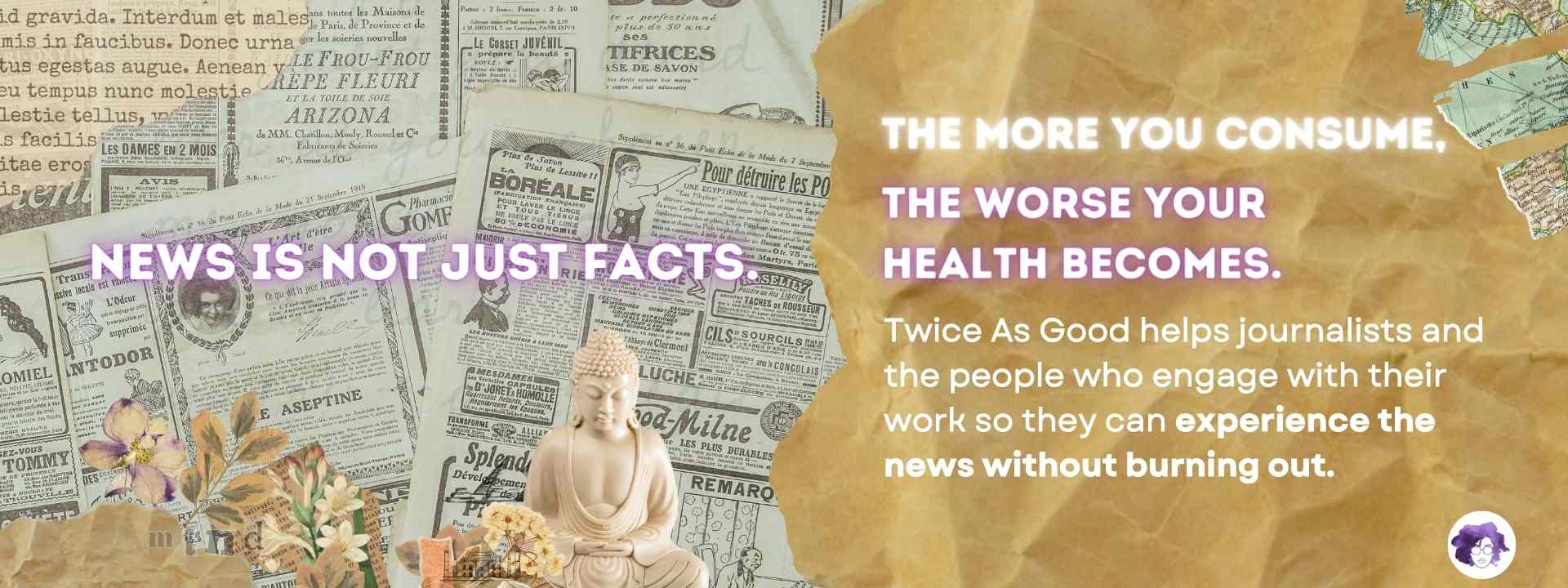
People are sick of the way news is done, and no one is more sick of it than journalists. As a journalist, I combined my training with my experience as a Buddhist podcast producer and came up with the term ‘mindful Black journalism.’ Learn what that is, why I’m doing it, and how it works.
About a year ago I set out to do journalism differently, through a Black lens, and for Black people. It led me to combine what I’ve learned as a podcast producer at a Buddhist magazine, together with what I learned in my career as a journalist. As a result, I ended up coining a term: 'mindful Black journalism.'
What is that?
On the surface, the term is simply a way of formalizing high quality journalism in service of Black communities. But if you really want to know how it all comes back to Black, you first need to know a little bit about the slow movement, how that connects to journalism, and what all that has to do with mindfulness.
Sometime in the 90’s after McDonald’s became the largest fast food chain in the world and America’s youth were experiencing an obesity epidemic, the slow food movement was born. As opposed to fast food, which would arrive within 15 minutes, these restaurants took their sweet time making delectable dishes that could be savoured for however long it takes. Patrons would be made aware of where the ingredients came from and how the dish was made, thus transforming the mindless act of eating into an enjoyable experience. (Not to mention, it was usually healthier and better for the planet).
Well, journalism caught that too. In ‘slow journalism,’ we take extra time and care to create a news experience with real impact. This form of journalism is gaining popularity as people grow sick and tired of endlessly consuming information without reason or purpose, causing them to only feel less informed, and more powerless.
A similar type of reporting is called ‘solutions journalism,’ where we take more time to cover a story and try to find ways to solve the problem that the story is covering.
Both forms of journalism, and most of the best non-fiction narratives in history, fit the criteria of mindful journalism. They are stories written with sincerity, balance, accuracy, compassion, curiosity, equanimity, and presence.

I speak a lot about problems in journalism, from the lack of diversity in Canadian newsrooms, to the foundations of journalism training. We were taught to never show weakness or human flaws, to be ready for work any time of the day or night, to be willing to give up our homes and our relationships for the sake of the job. To prove ourselves, we thought we had to become superhuman. It’s no surprise we were warned so early in the program: only a small percentage of us would actually end up working in journalism. From my program, I know of less than ten who are working in news today.
To make matters worse, those who do manage to prove themselves worthy of this low-pay, high stress job, are overwhelmingly white and privileged. Privilege really comes in handy when you’re working as a freelancer on a front page story for minimum wage, or when you lose your apartment because you got laid off.
The last 27 years of home internet in America has destroyed many news outlets. It took a long time for newspapers to figure out how to make money back when everything on the internet was free, but the worst-hit outlets were local. In the last 10 years, 189 community newspapers have shut down in Canada. In the United States even more newspapers have shut down, in even less time, leaving news giants like CNN and Fox to set the standard of journalism.
I believe the future of journalism involves resisting the manic 24/7 news cycle, and pushing back against fast paced news so that staying informed doesn’t destroy journalists and the people who engage with their work.
BIPOC journalists are probably nodding or snapping their fingers at this point, because they know better than anyone how shortsighted journalism can hurt people. In newsrooms they’re often told their pitches aren’t relevant, they get boxed in to doing all the ‘ethnic’ stories, or they get overlooked. Statistically, they get promoted less often, and they’re promoted to leadership positions even less often. In any case, they’re less likely to be paid the same as their counterparts. The U.S. documentary Black in the newsroom illustrates my point. It focuses on Elizabeth Montgomery. She landed her dream job at a major media organization, going on to write some of their most popular stories, only to be underpaid and unable to pay for groceries while another journalist with less experience earned thousands more.
People are sick of the way news is done, but perhaps no one is more sick of it than the journalists themselves.
This is where Twice As Good comes in. The name is a reference to the concept that as Black people we have to work two times harder for half the reward that our white counterparts receive. I believe that to fight that injustice and change journalism for the better, we urgently need journalists who practice mindfulness, and the ethics that go with it.
The newsletter is my way of demonstrating for a Black audience how slow, mindful journalism can be more helpful than fast news.
As one example, The Eightfold Path found in Buddhism (where mindfulness comes from) can make a pretty solid reference point for the working journalist:
Commit to fair and balanced reporting, accepting the myth of objectivity, acknowledging biases, and withholding judgement until all the facts are in.
Acknowledge the end goal or benefit of any given story. Is it for clout or respect? To help the subject? To inform the community? Take down a politician? Hold that intention, question it, and ensure your goal is to be of benefit to someone in need.
When writing, speaking, or communicating in any way, ask yourself these questions first: is it true and factual? Does it create harmony? Is it gentle? Is it beneficial? Am I speaking/writing with a mind of goodwill? Is this the right time?
Sometimes it means refusing a gift—or accepting one—or even stepping in to help. Strike the balance between ethical action and non-action. Should you interfere with a story by getting involved? How will you make sure the subject and the readers are best served by this action or non-action?
Reconnect with why you became a journalist instead of a marketing strategist (with twice the salary). Losing sight of the reason you got into journalism can lead to destructive cynicism.
Cynicism and apathy are counter to genuinely exposing problems and finding solutions. Make a regular practice of finding new ways to combat these ills.
Meditate to be present in daily life. Develop practices for keeping a clear mind. This is a lifelong endeavour.
This is the culmination of all the steps that can lead you to see the truth of things. By developing a mindful journalism practice, we actively resist the hustle and bustle so that it can't cloud our hearts and minds.
I’ll be sharing this and more on resisting fast news culture for BIPOC journalists at the (virtual) RISE Conference, May 26-27.
